The 1955 Mercedes-Benz 300SL, a name synonymous with automotive excellence, bursts onto the scene with its iconic gullwing doors and a legacy that continues to captivate enthusiasts today. This legendary sports car, born in the golden age of motorsport, redefined performance and design, leaving an indelible mark on the world of automobiles.
Its story is one of innovation, daring, and a pursuit of pushing boundaries, a testament to the engineering prowess and artistic vision of Mercedes-Benz.
The 300SL’s design was a masterpiece, a harmonious blend of form and function. The gullwing doors, a groundbreaking feature that became synonymous with the car, were not just a stylistic choice but a necessity born from the lightweight tubular space frame construction.
This innovative engineering solution allowed for a low center of gravity, contributing to the 300SL’s exceptional handling and agility. Under the hood, a powerful 3.0-liter inline-six engine roared with a symphony of power, propelling the car to speeds previously unheard of, solidifying its position as a performance icon.
The 1955 Mercedes-Benz 300SL: A Legend in the Making
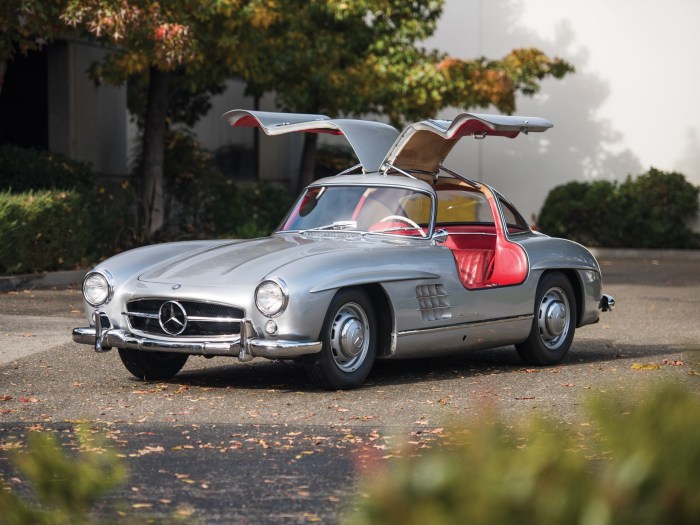
The 1955 Mercedes-Benz 300SL, officially known as the “300 Sport Leicht” or “300 SL,” is a legendary sports car that revolutionized automotive design and performance. This iconic vehicle, introduced in 1954, became a symbol of German engineering excellence and a cornerstone of Mercedes-Benz’s motorsport legacy.
The 300SL’s story is deeply intertwined with the world of racing. Its genesis lies in the desire to create a competitive racing car for the grueling 1952 Carrera Panamericana, a dangerous road race across Mexico. The 300SL, with its innovative gullwing doors and lightweight construction, quickly became a force to be reckoned with on the racetrack.
The 300SL’s Distinctive Features and Innovations
The 300SL’s design was a testament to both engineering prowess and aesthetic vision. Its defining feature, the gullwing doors, was born out of necessity. To achieve the desired lightweight construction, the engineers opted for a tubular space frame chassis, which left little room for conventional doors.
The innovative gullwing design, hinged at the roofline, provided a unique and elegant solution.
- Gullwing Doors:This iconic feature, hinged at the roofline, provided a distinctive profile and a practical solution for entry and exit in a car with a tubular space frame chassis.
- Tubular Space Frame Chassis:This lightweight yet robust design, inspired by aircraft construction, contributed significantly to the car’s performance and handling.
- Powerful 3.0-Liter Inline-Six Engine:The 300SL was powered by a fuel-injected, 3.0-liter inline-six engine, producing an impressive 215 horsepower, making it one of the fastest cars of its time.
- Aerodynamic Design:The 300SL featured a streamlined body with a low drag coefficient, further enhancing its performance.
- Independent Suspension:The car’s independent suspension system, both front and rear, ensured superior handling and ride comfort.
Design and Engineering: 1955 Mercedes-Benz 300SL
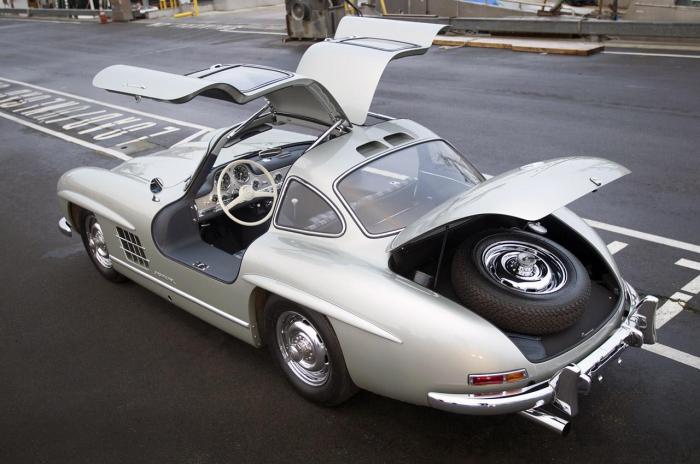
The 1955 Mercedes-Benz 300SL was a masterpiece of automotive design and engineering, pushing the boundaries of performance and style. Its innovative features, including the iconic gullwing doors and lightweight construction, revolutionized the sports car world and cemented its place in automotive history.
Gullwing Doors
The gullwing doors, a defining characteristic of the 300SL, were not merely a stylistic choice. They were a practical solution to a design challenge. The 300SL’s tubular space frame chassis, designed for maximum rigidity and lightness, left little room for conventional doors.
To provide access to the cabin, engineers devised the innovative gullwing design, which hinged at the roofline and swung upward like a bird’s wings. This design offered ample entry and exit space while maintaining the structural integrity of the chassis.
Tubular Space Frame Construction
The 300SL’s lightweight tubular space frame construction was another groundbreaking innovation. This revolutionary design, inspired by aircraft engineering, consisted of a network of interconnected steel tubes that formed a rigid yet lightweight structure. The space frame construction provided exceptional strength and torsional rigidity, essential for handling the high speeds and demanding driving conditions the 300SL was designed for.
This construction technique, pioneered by Mercedes-Benz, significantly reduced the car’s weight, contributing to its exceptional performance.
Powerful 3.0-Liter Inline-Six Engine
The 300SL was powered by a potent 3.0-liter inline-six engine, a masterpiece of mechanical engineering. This engine, featuring fuel injection and a high compression ratio, produced an impressive 215 horsepower, allowing the 300SL to reach a top speed of over 160 mph, a remarkable achievement for its time.
The engine’s smooth power delivery and high-revving capabilities made the 300SL a thrilling driving experience, further solidifying its reputation as a true performance icon.
The 1955 Mercedes-Benz 300SL, with its iconic gullwing doors, is a timeless classic. It’s a reminder of a time when Mercedes-Benz was pushing the boundaries of automotive design. While the 300SL was a pure sports car, Mercedes-Benz later shifted gears, introducing the luxurious 1973 Mercedes-Benz 450 , a grand tourer that redefined comfort and performance.
The 300SL, with its raw power and aggressive styling, still holds a special place in the hearts of car enthusiasts, a testament to the enduring legacy of Mercedes-Benz.
Racing Heritage
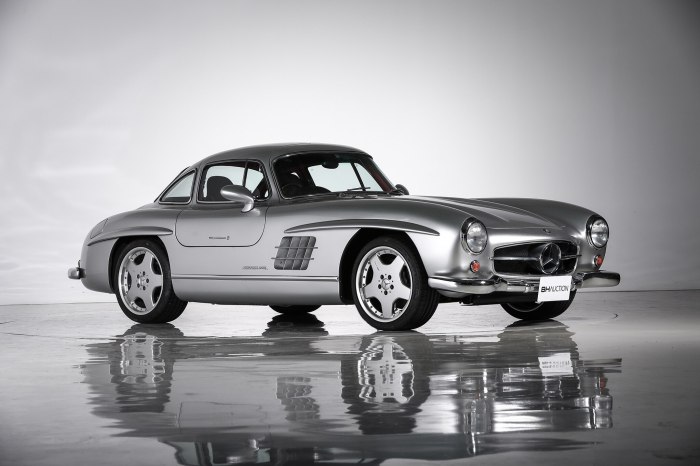
The 1955 Mercedes-Benz 300SL wasn’t just a stunning sports car; it was a racing machine designed to dominate the tracks. Its success in motorsport, particularly at the 1955 Mille Miglia, cemented its legendary status and propelled Mercedes-Benz to the forefront of the automotive world.
The 1955 Mille Miglia
The 1955 Mille Miglia, a grueling 1,000-mile road race through Italy, was a defining moment for the 300SL. Driven by Stirling Moss and Denis Jenkinson, the 300SL took the lead early and maintained it throughout the race. Despite the intense competition and challenging conditions, Moss and Jenkinson finished with a record-breaking time, securing a dominant victory for Mercedes-Benz.
This victory solidified the 300SL’s reputation as a formidable racing machine and a testament to Mercedes-Benz’s engineering prowess.
Legendary Drivers and Their Stories, 1955 Mercedes-Benz 300SL
The 300SL attracted some of the most legendary drivers of the era. Stirling Moss, a renowned British driver, not only won the 1955 Mille Miglia but also achieved numerous other victories in the 300SL. His skill and daring behind the wheel contributed significantly to the car’s racing legacy.
Juan Manuel Fangio, another racing legend, also drove the 300SL, demonstrating its capabilities and contributing to its iconic status. These drivers, along with others who raced the 300SL, played a crucial role in showcasing the car’s performance and endurance, further solidifying its place in motorsport history.
Impact on Brand Reputation
The 300SL’s racing success had a profound impact on Mercedes-Benz’s brand reputation. The car’s victories, particularly at the 1955 Mille Miglia, established Mercedes-Benz as a leader in motorsport and a producer of high-performance, innovative automobiles. This reputation for excellence in both design and engineering has continued to resonate with customers worldwide, solidifying Mercedes-Benz’s position as a luxury and performance brand.
Production and Evolution
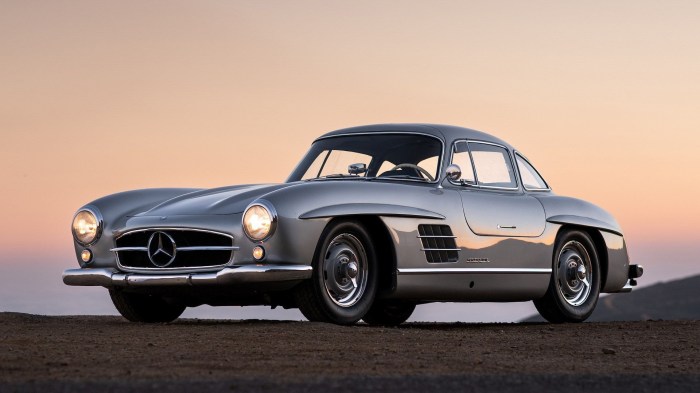
The 300SL’s production was a testament to its exclusivity and engineering prowess. Its limited production run, coupled with its innovative design and performance, solidified its place as a legend in the automotive world.The 300SL’s production journey involved a transition from its iconic gullwing coupe to a roadster variant, each iteration reflecting advancements in design and engineering.
This evolution not only enhanced the car’s aesthetics but also improved its practicality and accessibility.
The Gullwing Coupe: A Limited Production Run
The 300SL gullwing coupe was a marvel of engineering, boasting a lightweight tubular spaceframe chassis and a powerful 3.0-liter straight-six engine. Production commenced in 1954 and continued until 1957, with only 1,400 units being produced. This limited production run was a result of the car’s complex manufacturing process and its high price tag.
The gullwing doors, while aesthetically stunning, required intricate engineering and meticulous craftsmanship. The 300SL was a hand-built masterpiece, and its production was a testament to the dedication and skill of Mercedes-Benz engineers and craftsmen.
The 1955 Mercedes-Benz 300SL, with its iconic gullwing doors, was a masterpiece of automotive design and engineering. While the 300SL was a purebred sports car, Mercedes-Benz continued its legacy of luxury and performance with the 1973 Mercedes-Benz 280.
This model, a more refined and practical sedan, carried the torch of German engineering, showcasing a balance of comfort and agility that would become synonymous with the brand. And just like the 300SL, the 280 solidified Mercedes-Benz’s position as a leader in automotive innovation.
The Roadster: A More Accessible Option
In 1957, Mercedes-Benz introduced the 300SL roadster, a more accessible variant that retained the car’s iconic styling and performance. The roadster featured a conventional convertible top, making it more practical for everyday use. This design change significantly expanded the car’s appeal, attracting a wider audience.
The 1955 Mercedes-Benz 300SL, a legendary sports car with its iconic gullwing doors, was a testament to German engineering prowess. It was a stark contrast to the more understated, but equally refined, 1991 Mercedes-Benz 300 , which embodied the brand’s shift towards a more contemporary aesthetic.
Despite their distinct personalities, both models reflected Mercedes-Benz’s unwavering commitment to quality and performance, leaving an enduring legacy in the automotive world.
The roadster’s production continued until 1963, with over 1,800 units being produced. The roadster’s popularity further solidified the 300SL’s legacy, making it one of the most sought-after and collectible classic cars in the world.
Design and Engineering Advancements
Throughout its production run, the 300SL underwent several design and engineering advancements, enhancing its performance and driving experience.
Engine and Performance
- The 300SL’s 3.0-liter straight-six engine was initially rated at 215 horsepower, but it was later upgraded to 240 horsepower in 1958.
- The engine’s power output was further enhanced with the introduction of fuel injection in 1958, resulting in an increase to 240 horsepower.
- The introduction of fuel injection also improved the engine’s responsiveness and efficiency.
Suspension and Handling
- The 300SL’s suspension was designed for both comfort and performance. It featured independent front suspension with coil springs and a rigid rear axle with semi-elliptical leaf springs.
- The car’s handling was further enhanced with the introduction of disc brakes in 1958, which provided superior stopping power and reduced brake fade.
Interior and Comfort
- The 300SL’s interior was designed for both luxury and practicality. It featured leather upholstery, a wood-rimmed steering wheel, and a comprehensive instrument panel.
- The roadster variant featured a folding soft top, which provided protection from the elements while still allowing for an open-air driving experience.
Legacy and Influence
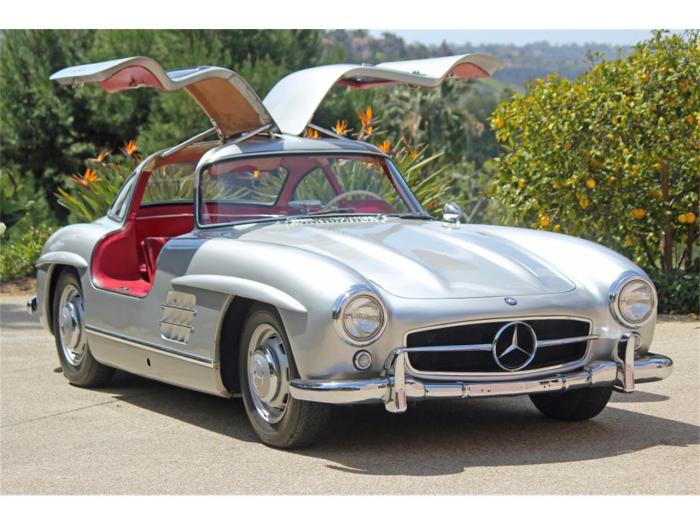
The 1955 Mercedes-Benz 300SL’s impact extends far beyond its remarkable performance and striking design. It has left an indelible mark on automotive history, influencing generations of carmakers and inspiring countless enthusiasts. This section delves into the 300SL’s enduring legacy and its profound influence on automotive design, engineering, and culture.
Influence on Subsequent Mercedes-Benz Models
The 300SL’s innovative design elements and engineering solutions paved the way for future Mercedes-Benz models. The gullwing doors, initially designed for ease of entry and exit in the race car, became a signature feature for the brand. The 300SL’s lightweight tubular spaceframe construction, a revolutionary approach for its time, influenced the development of subsequent Mercedes-Benz sports cars, contributing to their exceptional handling and performance.
The 1955 Mercedes-Benz 300SL, with its iconic gullwing doors, is a classic example of automotive engineering brilliance. While the original 300SL was a groundbreaking sports car, Mercedes-Benz continued the legacy with the 1985 Mercedes-Benz 300SL , a sleek and powerful roadster that built upon the original’s reputation for performance and luxury.
Both cars stand as testaments to Mercedes-Benz’s enduring commitment to pushing the boundaries of automotive design and engineering.
The 300SL’s powerful engine, known for its reliability and performance, laid the foundation for the development of Mercedes-Benz’s legendary high-performance engines. The 300SL’s influence can be seen in numerous Mercedes-Benz models, from the iconic SL-Class to the high-performance AMG models.
Collecting and Restoration
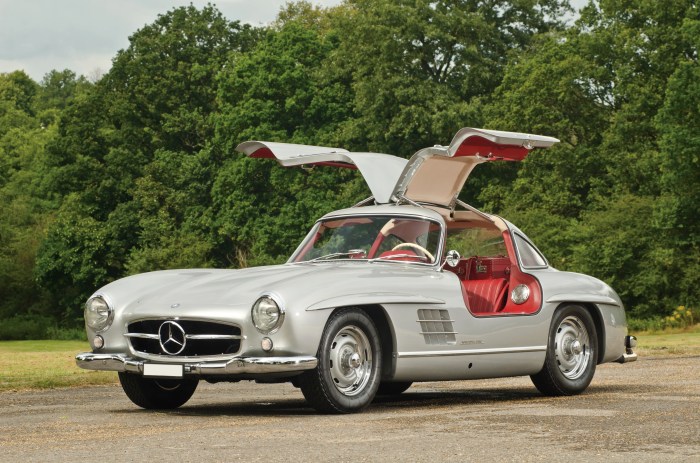
The 1955 Mercedes-Benz 300SL, a symbol of automotive excellence and a testament to German engineering prowess, has captured the hearts of collectors worldwide. Its sleek design, impressive performance, and rich racing heritage make it a highly sought-after classic car. The 300SL’s enduring appeal translates into significant value, making it a coveted asset in the world of automotive collecting.The process of restoring and maintaining a 300SL is a meticulous undertaking, requiring specialized knowledge and a commitment to preserving its historical significance.
Restoring a 300SL involves a comprehensive approach, from assessing the car’s condition to sourcing authentic parts and employing skilled craftsmanship to return it to its former glory.
Restoring a 300SL
Restoring a 300SL is a labor of love, demanding a blend of expertise, passion, and a keen eye for detail. The process typically involves the following steps:
- Assessment:A thorough inspection is crucial to determine the extent of restoration required. This involves evaluating the car’s body, engine, transmission, interior, and other components. The assessment helps identify areas that need attention and guides the restoration plan.
- Disassembly:Once the assessment is complete, the 300SL is carefully disassembled. This allows for a more thorough inspection of each component and facilitates access for restoration work.
- Bodywork:Restoring the bodywork is a critical aspect of the restoration process. This involves repairing any damage, addressing rust, and ensuring the body is structurally sound. Depending on the condition, the body may need to be repainted to its original color and finish.
- Engine and Transmission:The engine and transmission are meticulously rebuilt to ensure optimal performance. This may involve replacing worn components, machining parts, and tuning the engine to factory specifications.
- Interior:The interior is restored to its original condition. This includes reupholstering the seats, replacing worn carpets and headliner, and restoring the dashboard and other interior components.
- Assembly and Testing:Once all components are restored, the 300SL is carefully reassembled. Extensive testing is then conducted to ensure all systems are functioning properly and the car meets original specifications.
Maintaining a 300SL
Maintaining a 300SL requires a dedicated approach to ensure its longevity and preserve its value. Regular servicing, proper storage, and careful driving are essential for keeping this classic car in top condition.
- Regular Servicing:The 300SL requires regular servicing by a qualified mechanic specializing in classic cars. This includes oil changes, filter replacements, brake inspections, and other routine maintenance tasks.
- Proper Storage:Storing the 300SL in a climate-controlled environment helps protect it from the elements. This minimizes the risk of rust, damage, and deterioration. A car cover can also help protect the paint and interior.
- Careful Driving:Driving a 300SL requires a gentle touch. Avoid aggressive acceleration, hard braking, and driving in harsh conditions. It’s essential to treat this classic car with respect and understand its limitations.
Value and Desirability
The 1955 Mercedes-Benz 300SL is highly prized by collectors due to its rarity, performance, and historical significance. The Gullwing Coupe and Roadster variants, each with their distinct characteristics, command significant values in the collector car market.
- Rarity:The limited production run of the 300SL, with only 1,400 Gullwing Coupes and 1,858 Roadsters produced, contributes to its rarity and desirability. This exclusivity makes the 300SL a highly sought-after collectible.
- Performance:The 300SL’s impressive performance, thanks to its powerful engine and lightweight design, further enhances its appeal. Its ability to reach speeds exceeding 160 mph (257 km/h) made it a formidable competitor in its time and continues to impress today.
- Historical Significance:The 300SL’s racing heritage, particularly its victories at the 1955 Mille Miglia and the 1955 24 Hours of Le Mans, solidified its place in automotive history. This historical significance adds to its allure and value.
Value of Different 300SL Variants
The value of a 300SL varies significantly depending on its variant, condition, and provenance. Here’s a table comparing the estimated values of different 300SL variants and conditions:
| Variant | Condition | Estimated Value |
|---|---|---|
| Gullwing Coupe | Excellent | $1,500,000
|
| Gullwing Coupe | Good | $800,000
|
| Roadster | Excellent | $1,200,000
|
| Roadster | Good | $600,000
|
Epilogue
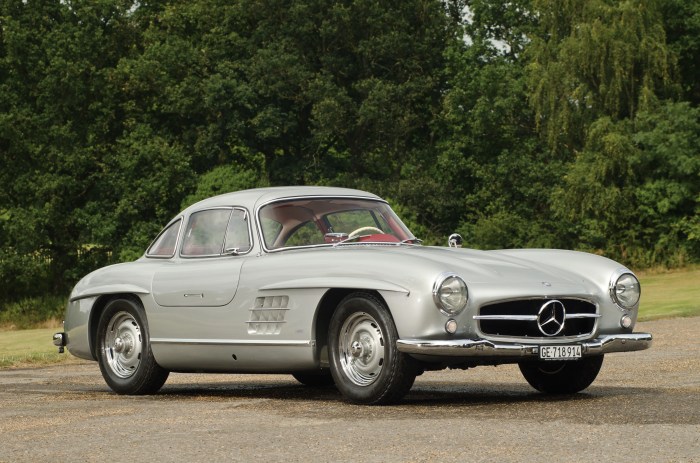
The 1955 Mercedes-Benz 300SL, more than just a car, is a testament to human ingenuity and a timeless icon. Its legacy continues to inspire, its design elements echoing in modern Mercedes-Benz models, and its spirit of innovation lives on in the automotive world.
Whether it’s the awe-inspiring sight of its gullwing doors opening, the roar of its powerful engine, or the stories of its racing victories, the 300SL holds a special place in automotive history, a symbol of a golden era of automotive design and engineering.